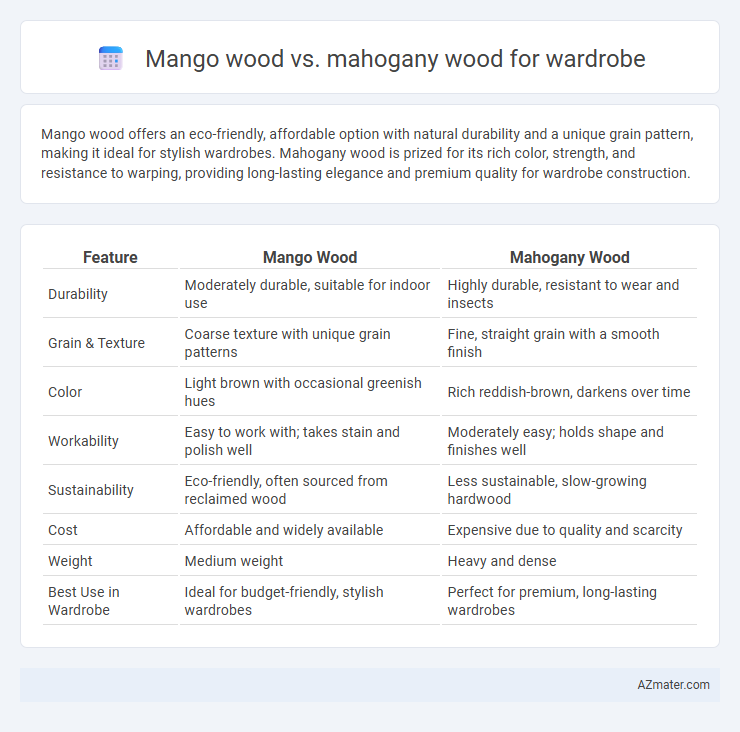Mango wood offers an eco-friendly, affordable option with natural durability and a unique grain pattern, making it ideal for stylish wardrobes. Mahogany wood is prized for its rich color, strength, and resistance to warping, providing long-lasting elegance and premium quality for wardrobe construction.
Table of Comparison
| Feature | Mango Wood | Mahogany Wood |
|---|---|---|
| Durability | Moderately durable, suitable for indoor use | Highly durable, resistant to wear and insects |
| Grain & Texture | Coarse texture with unique grain patterns | Fine, straight grain with a smooth finish |
| Color | Light brown with occasional greenish hues | Rich reddish-brown, darkens over time |
| Workability | Easy to work with; takes stain and polish well | Moderately easy; holds shape and finishes well |
| Sustainability | Eco-friendly, often sourced from reclaimed wood | Less sustainable, slow-growing hardwood |
| Cost | Affordable and widely available | Expensive due to quality and scarcity |
| Weight | Medium weight | Heavy and dense |
| Best Use in Wardrobe | Ideal for budget-friendly, stylish wardrobes | Perfect for premium, long-lasting wardrobes |
Introduction to Mango Wood and Mahogany Wood
Mango wood, derived from the fast-growing mango tree, is a sustainable and eco-friendly option known for its durability and unique grain patterns suitable for wardrobes. Mahogany wood, prized for its rich reddish-brown color and exceptional strength, offers premium quality and classic appeal in wardrobe construction. Both woods provide distinct aesthetics and functional benefits, with mango wood being more affordable and mahogany wood offering enhanced longevity.
Appearance and Grain Patterns
Mango wood features a light to medium brown hue with occasional green or yellow undertones, marked by irregular grain patterns that add a rustic charm to wardrobes. Mahogany wood boasts a rich reddish-brown color with a fine, straight grain that creates a smooth and elegant finish ideal for classic or luxurious wardrobe designs. The pronounced grain and color variations in mango wood lend a more casual and textured appearance, while mahogany's consistent and refined grain ensures a polished and sophisticated aesthetic.
Durability and Hardness
Mango wood offers moderate durability and hardness, making it resistant to scratches and suitable for wardrobe construction, though it is softer than mahogany. Mahogany is known for its exceptional durability and high hardness, providing superior resistance to dents and wear, ideal for long-lasting and sturdy wardrobes. Choosing mahogany ensures greater structural integrity, while mango wood provides a cost-effective and eco-friendly alternative with decent strength.
Sustainability and Environmental Impact
Mango wood is a highly sustainable choice for wardrobes due to its fast growth cycle and status as a byproduct of fruit farming, which reduces deforestation impact compared to mahogany, a slow-growing hardwood often linked to illegal logging and habitat loss. Mahogany has a richer, deeper grain but poses significant environmental concerns because of overharvesting and habitat degradation, making mango wood a more eco-friendly alternative. Using mango wood supports responsible forestry practices by utilizing plantation timber, thereby lowering carbon footprints and promoting biodiversity conservation in wardrobe manufacturing.
Weight and Workability
Mango wood is lighter and easier to work with compared to mahogany, making it ideal for wardrobes that require intricate designs or frequent relocation. Mahogany, being denser and heavier, offers superior durability and strength but demands more effort in cutting and shaping. Both woods provide excellent finishes, but mango wood's moderate weight enhances its versatility for wardrobe construction.
Cost Comparison
Mango wood is generally more affordable than mahogany wood, making it an economical choice for wardrobe construction without sacrificing durability. Mahogany wood commands a higher price due to its premium quality, rich color, and natural resistance to decay, often reflected in luxury furniture pricing. Choosing mango wood offers cost savings while maintaining medium hardness and good strength, ideal for budget-conscious consumers seeking quality wardrobes.
Maintenance and Care
Mango wood wardrobes require minimal maintenance, being naturally resistant to moisture and pests, while occasional polishing with natural oils enhances their durability and sheen. Mahogany wood demands more diligent care, including regular polishing to prevent drying and cracking, and protection from excessive humidity that can cause warping or mold. Both woods benefit from cleaning with a soft, dry cloth and avoiding harsh chemicals to preserve their rich finishes and structural integrity.
Suitability for Wardrobe Construction
Mango wood offers a durable and eco-friendly option for wardrobe construction, known for its strength, resistance to warping, and unique grain patterns that enhance aesthetics. Mahogany wood, prized for its rich color, smooth texture, and excellent durability, provides superior resistance to decay and insect damage, making it ideal for long-lasting, high-end wardrobes. Both woods are suitable for wardrobe construction, but mango wood is often favored for cost-effective and sustainable solutions, while mahogany suits premium furniture requiring luxurious finishes and exceptional durability.
Pros and Cons of Mango Wood Wardrobes
Mango wood wardrobes offer durability and sustainability, as mango wood is an eco-friendly alternative with a unique grain pattern and rich color variations. These wardrobes resist warping and are generally more affordable than mahogany, but they tend to be softer and less resistant to scratches and dents. Compared to mahogany, mango wood requires more frequent maintenance to preserve its aesthetic appeal and longevity in wardrobe construction.
Pros and Cons of Mahogany Wood Wardrobes
Mahogany wood wardrobes offer exceptional durability, rich reddish-brown color, and natural resistance to rot and insects, making them a long-lasting and elegant choice for bedroom furniture. However, mahogany is typically more expensive than mango wood, and its dense grain can make it harder to work with during custom designs or repairs. Compared to mango wood wardrobes, which are lighter and more affordable with a unique grain pattern, mahogany wardrobes excel in strength and prestige but may require higher maintenance to preserve their polished finish.

Infographic: Mango wood vs Mahogany wood for Wardrobe
 azmater.com
azmater.com